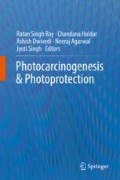Abstract
The human skin remains under constant exposure of solar radiation and is vulnerable to epigenetic modifications that later may develop skin cancer. The effects of chronic UVR exposure to skin can alter epigenetic information in epidermal cells, leading to epigenetic mosaicism. These epigenetic changes include DNA methylation, chromatin modifications, and posttranscriptional modifications of noncoding RNAs. UVR-induced epigenetic changes are not irreversible. Certain phytochemicals can potentially inhibit cancer signaling pathways which are usually deregulated by epigenetic mechanisms. Indeed, recent therapeutic strategies are directing toward phytochemical-based reversal of epigenetic modifications to combat UVR-induced skin cancers. This chapter provides detailed insights of different epigenetic alterations, their role in photocarcinogenesis, and phytochemical-based reversal of epigenetic changes occurring in UVR-irradiated skin.
Access this chapter
Tax calculation will be finalised at checkout
Purchases are for personal use only
References
O’Shaughnessy JA, Kelloff GJ, Gordon GB, Dannenberg AJ, Hong WK, Fabian CJ, Sigman CC, Bertagnolli MM, Stratton SP, Lam S, Nelson WG (2002) Treatment and prevention of intraepithelial neoplasia: an important target for accelerated new agent development: recommendations of the American Association for Cancer Research Task Force on the Treatment and Prevention of Intraepithelial Neoplasia. Clin Cancer Res 8(2):314–346
Jones PA, Baylin SB (2002) The fundamental role of epigenetic events in cancer. Nat Rev Genet 3(6):415
Laird PW, Jaenisch R (1996) The role of DNA methylation in cancer genetics and epigenetics. Annu Rev Genet 30(1):441–464
Baylin SB, Herman JG (2000) DNA hypermethylation in tumorigenesis: epigenetics joins genetics. Trends Genet 16(4):168–174
Goodman JI, Watson RE (2002) Altered DNA methylation: a secondary mechanism involved in carcinogenesis. Annu Rev Pharmacol Toxicol 42(1):501–525
Housman TS, Feldman SR, Williford PM, Fleischer AB, Goldman ND, Acostamadiedo JM, Chen GJ (2003) Skin cancer is among the most costly of all cancers to treat for the Medicare population. J Am Acad Dermatol 48(3):425–429
Bird AP (1986) CpG-rich islands and the function of DNA methylation. Nature 321(6067):209–213
Egger G, Liang G, Aparicio A, Jones PA (2004) Epigenetics in human disease and prospects for epigenetic therapy. Nature 429(6990):457
Jones PA, Laird PW (1999) Cancer-epigenetics comes of age. Nat Genet 21(2):163
Nandakumar V, Vaid M, Katiyar SK (2011) (−)-Epigallocatechin-3-gallate reactivates silenced tumor suppressor genes, Cip1/p21 and p 16 INK4a, by reducing DNA methylation and increasing histones acetylation in human skin cancer cells. Carcinogenesis 32(4):537–544
Ma H, Baumann CT, Li H, Strahl BD, Rice R, Jelinek MA, Aswad DW, Allis CD, Hager GL, Stallcup MR (2001) Hormone-dependent, CARM1-directed, arginine-specific methylation of histone H3 on a steroid-regulated promoter. Curr Biol 11(24):1981–1985
Berger JR (2007) Progressive multifocal leukoencephalopathy. Handb Clin Neurol 85:169–183
Kouzarides T (2007) Histone-modifying enzymes. Cell 128:693
Druesne N, Pagniez A, Mayeur C, Thomas M, Cherbuy C, DuÈe PH, Martel P, Chaumontet C (2004) Diallyl disulfide (DADS) increases histone acetylation and p21 waf1/cip1 expression in human colon tumor cell lines. Carcinogenesis 25(7):1227–1236
Choudhuri S, Cui Y, Klaassen CD (2010) Molecular targets of epigenetic regulation and effectors of environmental influences. Toxicol Appl Pharmacol 245(3):378–393
Nakayama JI, Rice JC, Strahl BD, Allis CD, Grewal SI (2001) Role of histone H3 lysine 9 methylation in epigenetic control of heterochromatin assembly. Science 292(5514):110–113
Shimada M, Haruta M, Niida H, Sawamoto K, Nakanishi M (2010) Protein phosphatase 1γ is responsible for dephosphorylation of histone H3 at Thr 11 after DNA damage. EMBO Rep 11(11):883–889
Hauptman N, Glavac D (2013) MicroRNAs and long non-coding RNAs: prospects in diagnostics and therapy of cancer. Radiol Oncol 47(4):311–318
Dziunycz P, Iotzova-Weiss G, Eloranta JJ, Läuchli S, Hafner J, French LE, Hofbauer GF (2010) Squamous cell carcinoma of the skin shows a distinct microRNA profile modulated by UV radiation. J Investig Dermatol 130(11):2686
Sha J, Gastman BR, Morris N, Mesinkovska NA, Baron ED, Cooper KD, McCormick T, Arbesman J, Harter ML (2016) The response of microRNAs to solar UVR in skin-resident melanocytes differs between melanoma patients and healthy persons. PLoS One 11(5):e0154915
Connelly CM, Thomas M, Deiters A (2012) High-throughput luciferase reporter assay for small-molecule inhibitors of microRNA function. J Biomol Screen 17(6):822–828
Author information
Authors and Affiliations
Corresponding author
Editor information
Editors and Affiliations
Rights and permissions
Copyright information
© 2018 Springer Nature Singapore Pte Ltd.
About this chapter
Cite this chapter
Yadav, N., Tripathi, A.K., Banerjee, M. (2018). UVR-Induced Epigenetic Regulation and Photocarcinogenesis. In: Ray, R., Haldar, C., Dwivedi, A., Agarwal, N., Singh, J. (eds) Photocarcinogenesis & Photoprotection. Springer, Singapore. https://doi.org/10.1007/978-981-10-5493-8_2
Download citation
DOI: https://doi.org/10.1007/978-981-10-5493-8_2
Published:
Publisher Name: Springer, Singapore
Print ISBN: 978-981-10-5492-1
Online ISBN: 978-981-10-5493-8
eBook Packages: Biomedical and Life SciencesBiomedical and Life Sciences (R0)

